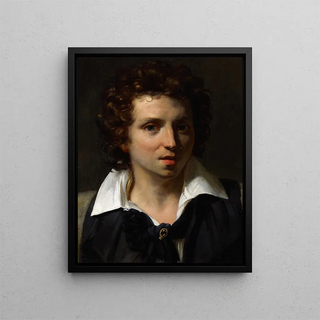Art print | Portrait of a Young Man - Théodore Géricault


View from behind

Frame (optional)
The "Portrait of a Young Man" by Théodore Géricault is a work that embodies both the finesse of artistic vision and the psychological depth of its subjects. Created in the early 19th century, this painting stands out for its intimate approach, capturing the essence of a young man whose expression appears both dreamy and melancholic. The artist, known for his commitment to realism and his exploration of human emotions, manages here to create an immediate connection between the viewer and the model. This portrait, much more than a simple representation, becomes a mirror of the soul, inviting each viewer to reflect on the thoughts and feelings hidden behind this face.
Style and uniqueness of the work
Géricault's style is characterized by a bold blend of realism and romanticism. In this art print, the detailed features of the young man's face and clothing are enhanced by rich, warm tones, creating an almost tangible atmosphere. The interplay of light and shadow is skillfully used to emphasize the model's features, giving him a striking presence. What makes this art print unique is Géricault's ability to transcend the simple portrait to offer a reflection on youth and the human condition. The gaze of the young man seems to carry an emotional weight, as if he is aware of the challenges and aspirations that lie ahead. This psychological depth, combined with the artist's technical mastery, makes this painting a timeless masterpiece that still resonates today.
The artist and his influence
Théodore Géricault, an emblematic figure of the Romantic movement, left a lasting mark on art history with his innovative vision and commitment to social themes. His career, though tragically cut short by illness, was marked by powerful works that explore human passions, suffering, and beauty. Géricault drew inspiration from the reality of his time, notably through subjects such as the shipwrecked of the Medusa, while maintaining a unique sensitivity towards his models. His influence extends beyond his era, inspiring many artists who followed in his footsteps, in search of truth and emotion.

Matte finish

View from behind

Frame (optional)
The "Portrait of a Young Man" by Théodore Géricault is a work that embodies both the finesse of artistic vision and the psychological depth of its subjects. Created in the early 19th century, this painting stands out for its intimate approach, capturing the essence of a young man whose expression appears both dreamy and melancholic. The artist, known for his commitment to realism and his exploration of human emotions, manages here to create an immediate connection between the viewer and the model. This portrait, much more than a simple representation, becomes a mirror of the soul, inviting each viewer to reflect on the thoughts and feelings hidden behind this face.
Style and uniqueness of the work
Géricault's style is characterized by a bold blend of realism and romanticism. In this art print, the detailed features of the young man's face and clothing are enhanced by rich, warm tones, creating an almost tangible atmosphere. The interplay of light and shadow is skillfully used to emphasize the model's features, giving him a striking presence. What makes this art print unique is Géricault's ability to transcend the simple portrait to offer a reflection on youth and the human condition. The gaze of the young man seems to carry an emotional weight, as if he is aware of the challenges and aspirations that lie ahead. This psychological depth, combined with the artist's technical mastery, makes this painting a timeless masterpiece that still resonates today.
The artist and his influence
Théodore Géricault, an emblematic figure of the Romantic movement, left a lasting mark on art history with his innovative vision and commitment to social themes. His career, though tragically cut short by illness, was marked by powerful works that explore human passions, suffering, and beauty. Géricault drew inspiration from the reality of his time, notably through subjects such as the shipwrecked of the Medusa, while maintaining a unique sensitivity towards his models. His influence extends beyond his era, inspiring many artists who followed in his footsteps, in search of truth and emotion.






